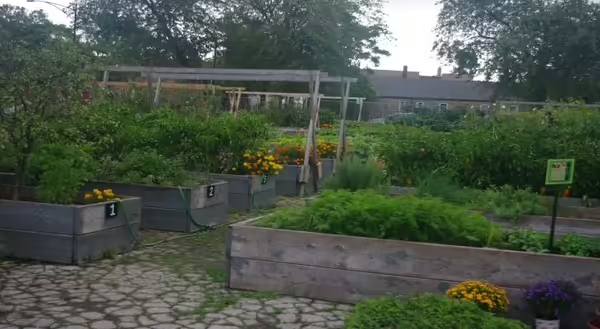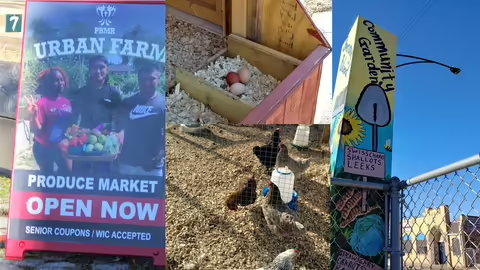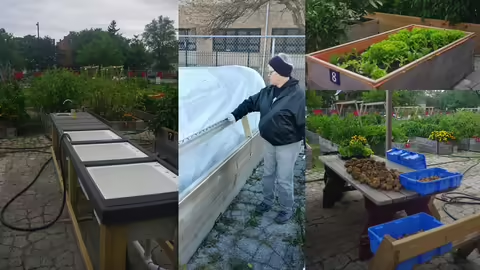
“One of the first things we learned during the Master Urban Farmer Training Program (MUFTP) was you can’t do everything,” explains Mary Harkenrider, urban farmer, Illinois Extension Master Gardener, and 2019 MUFTP graduate. “We’ve taken that lesson to heart. You have to define what you are there for because you’re pulled in all these different directions. So, we always go back and consider our primary goal to decide where we should be putting our energy.” Precious Blood Urban Farm’s mission is “cultivating relationships… through engagement, education, and access.”
The lesson Mary is referring to comes from the article The Unattainable Trifecta of Urban Agriculture. The authors make the case that “urban agriculture has emerged as a promising way to address many important issues, including growing food for local communities, preserving open space, promoting health, and developing local leaders” but an expectation has also emerged that urban agriculture should do all this and be financially sustainable without reliable or increased outside funding. Thus, an urban agriculture project can meet one, possibly two, but not all three of these goals.
- Provide good food to people with limited financial resources at prices they can afford.
- Provide job training, work experience, and/or leadership development for people typically excluded from these roles.
- Generate income for producers and create jobs funded by profits from sales.
A mission-focused farm
Straddling several neighborhoods on Chicago’s southside Precious Blood Urban Farm is part of Precious Blood Ministry of Reconciliation (PMBR) a not for profit restorative justice hub. PBMR serves “youth, families, and community members that reside in Chicago’s Back of the Yards/New City and Englewood neighborhoods who are impacted by violence and the criminal justice system.” The Center is known for its radical hospitality bringing hope, hospitality and healing to those it serves. It holds Peace Circles, offers educational and arts programs, and provides workforce development opportunities in the wood shop, screen printing, and the farm.
The farm evolved from a small community garden built on top of on an old parking lot in 2012. It is open to the community as a resource for food, conversation, education, and community-building. Since 2016 Mary, a former criminal justice lawyer and Sister Carolyn Hoying, a farmer from birth, have worked side by side as a team to transform the garden into an urban farm to provide nutritious food to area residents with limited financial resources, and provide work experience for those with difficulty entering the job market. Mary emphasizes “for us the farm supplements the work we all do at the Center in working towards healing in the community rather than being the focus itself.” They offer a variety of crops requested by area residents as well as flowers and herbs to make visiting the farm pleasing to the senses. Each year they work with youth 16-24 years old who are part of PMBR’s job readiness program teaching farming and job skills. Mary noted that “some youth stick around for several years, like brothers José and Fredo Chavez, others just for a season. But all become part of the farm family.”
Small size, impressive harvests
In each of the past two years the farm has used raised beds to produce over 2 tons of food utilizing less than 1/5 of an acre, about 7,790 square feet. Rather than income generation Mary and Sister Carolyn calculate the farm’s impact in pounds grown and the retail value of the produce supplied each year to neighborhood residents if it were sold at a local farmers market. In 2021 they distributed at least 4,725 pounds of fresh produce (in December they were still harvesting beets and chard) worth about $14,000. Impressive for a farm managed by volunteers whose mission is focused on cultivating relationships… through engagement, education, and access rather than on maximizing production. For comparison, Cook County Extension’s farm in Matteson, SoSuCo, produced 0.65 pounds per square foot in 2021 while the Precious Blood Urban Farm yielded 0.61 pounds per square foot. In comparison a report from Rutgers concludes that expected yields of 0.5 lbs/sq ft is a realistic estimate for small-scale mixed produce farms such as those found in urban areas. report yields Some might question if a small space in a large city should be called a farm. These productivity numbers show otherwise.
“Completing the Master Urban Farmer Training Program gave me confidence that there are many ways to do things. You just have to figure out what works best for you.” — Mary Harkenrider
Since completing the Master Urban Farmer Training Program Mary explains “we’re always looking to improve things. And I’ve learned you don’t have to do it the way someone else has done it. During Year 1 of the COVID pandemic we realized we needed to move beyond a hose for watering and washing our produce. Because I had completed MUFTP I was aware we needed a triple rinse and hand wash sink.” Mary partnered with Precious Blood Ministry’s woodshop to build the produce and hand washing stations to fit their space and needs. This is an ongoing partnership which brings young men in the woodshop program to the farm to build farm infrastructure such as raised beds, a coolbot mobile storage unit, tool sheds, a chicken coop, and a salad spinner stand.
Mary is especially proud of the stand, which cradles the salad spinner. She brought the woodshop trainees to the farm to demonstrate how she couldn’t control the spinner. It would constantly slip off tables and out of her hands. Once the woodshop trainees understood the problem, they worked together to build something to meet her needs.
“Our best days are when the woodshop is out on the farm. We’ve converted more young men to eating differently or growing food for their own families when they are out there building a raised bed or support structures.” — Mary Harkenrider
Mary also measures the farm’s success in what it does for the community. “We’ve become a place along 51st Street that is a place of beauty and a refuge of green space. Adults attending the Education Lab take breaks and walk through the farm to settle their mind. Families try asparagus for the first time and ask for more.” This year a third bed of asparagus was planted to meet this unexpected demand. By sticking to their mission, pooling resources, and slow and steady investment in infrastructure and production education Mary is confident in their plans to expand the farm in 2022 with a larger “field-type” raised bed so they are better able to grow more high-demand vining crops like melons and squash.
Favorite thing(s) to grow: “How can you pick just one thing? I love growing strawberries, raspberries, blackberries, cherries, and everyone who visits enjoys eating them. Fruit is a good way to introduce people to fresh produce,” says Mary. She also mentioned the joy of harvesting root vegetables like potatoes and sweet potatoes. Staff from the Center often come out for those harvests and are surprised when they see how much has been growing under the ground.
Shhh… it’s (was) a secret: In 2020 Mary joined Cook County Extension Advisory Council. The Extension Council is authorized by the University of Illinois Board of Trustees, in accordance with state law, to be actively involved in the operation of University of Illinois Extension. Extension Councils cooperate with Extension staff in planning, promoting, developing, implementing, evaluating, and financing an Extension program designed to meet the needs, interests, and resources of the local communities served.
What is a farm? According to the USDA’s Economic Research Service “A farm is defined as any place from which $1,000 or more of agricultural products were produced and sold, or normally would have been sold, during the year.” For the 2022 Ag Census, the USDA will also be counting urban farms who donate more than $1,000 of produce. To learn more about the USDA’s official definition of a farm and how to and why you should participate in the 2022 Census of Ag watch this video from the National Agricultural Statistics Service.
All photos by Kathryn M. Pereira
MEET THE AUTHOR
Kathryn Pereira is a local food systems and small farm educator with University of Illinois Extension serving Cook County. Raised on the southside of Chicago, her career in agriculture began in 1990 in Mozambique. Later she owned and operated an organic vegetable farm in New Hampshire before returning to the Midwest to earn her Master of Science in Agricultural and Applied Economics from University of Wisconsin–Madison. She regularly volunteers with USAID’s Farmer-to-Farmer Program in southern Africa and is passionate about improving small farmers’ income and quality of life as well as consumers’ access to local foods. She provides workshops, technical assistance consultations, site visits, and referrals to resources for urban and peri-urban food system projects, organizations, commercial farmers, and residents interested in urban agriculture and local food systems.


